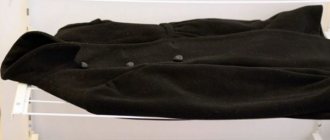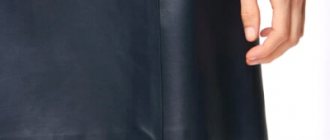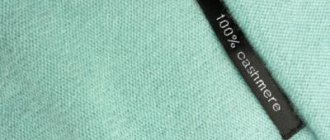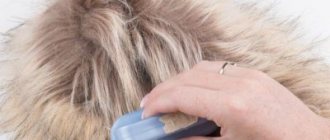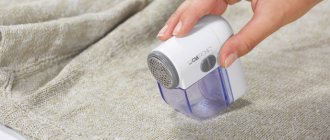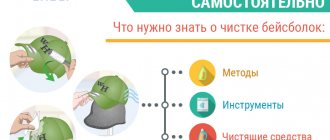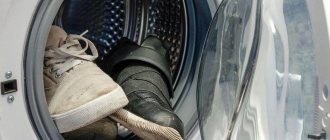How to wash a beret correctly
Find the label on the inside of the beret. It says:
- is it allowed to be washed or is it better to dry clean it;
- washing temperature.
Based on this information, you decide on the type of cleaning.
If washing is allowed, the headdress must be prepared:
- Remove light stains with a clothes brush or tape. Cut a piece of tape and use the sticky side to pick up dirt.
- Before using detergent, test it on an inconspicuous area.
Washing is contraindicated for fur and molded garments.
Wool knitted
Hand wash is a priority. Before washing, soak the beret for 2–3 hours in a solution of ammonia (1–1.5 tablespoons of ammonia per 2.5–3 liters of water).
Prepare in advance two medium-sized basins, baby shampoo, a clothes brush, a disk with a diameter slightly larger than a beret, and scissors.
- Carefully remove decorative elements from the beret. If that doesn't work, it's better to skip washing and dry clean.
- Pour water at a temperature of 35 degrees into both basins. Wool does not tolerate temperature changes during washing.
- Dissolve the shampoo in one bowl. Better - neutral children's without color and smell.
- Use gentle movements to help the product soak in water, leave for 1-2 minutes. Clean dirty areas with a clothes brush.
- Remove from shampoo container and allow soapy water to drain. Don't squeeze.
- Place in a bowl of clean water and rinse without sudden movements. Remove and let the water drain again.
- Turn inside out and without stretching, place on the disc and dry.
You cannot wash mohair or pure wool items in hot water - they “shrink”.
Felt
- Before washing, clean the beret with a soft brush or tape.
- Dissolve 4 tbsp in 10 liters of water. l. ammonium hydroxide, dip the cleaner in the solution and leave for an hour.
- Prepare water at a temperature no higher than 30 degrees, stir baby shampoo in it.
- Wash the beret with gentle movements, wring it lightly without twisting it.
- Place on the frame and dry.
To dry a headdress with an arrow, form it into a pancake shape and press it down with something heavy.
For stains, you can use Vanish carpet cleaner:
- Dilute in the proportions specified in the instructions.
- Apply the beret to the contaminated area.
- Let the foam absorb (dirt will be pushed out).
- Collect the dirty foamy slurry with a sponge.
- When the foam remains clean, the procedure can be completed.
Made from velor and angora
It is better to wash a beret made of velor or angora by hand. The water temperature should not exceed 30 degrees.
- Dissolve grated baby soap or neutral shampoo in water.
- Lightly kneading with your hands, wash the beret. You can't rub or twist it.
- Rinse in warm water. Do not rinse with ice cold tap water.
- Turn it inside out and place it on the round frame.
Tips for caring for items made from light angora:
- Add 20 ml of ammonia and hydrogen peroxide, 5 tbsp. to slightly warm water. l. salt and 50 g of baby shampoo.
- Soak the beret in this liquid for 3 hours. Turn in the solution once every 30 minutes.
- Wash with detergent, rinse in glycerin solution.
Made from fur
Fur items cannot be washed. There is dry and wet cleaning for them.
- Before cleaning, it is necessary to comb out any loose lumps and dirt from the lint with a brush.
- The fur of the Arctic fox is combed out with a coarse brush with cotton wool on it, so as not to damage the undercoat.
- The short-haired fur is covered with wet gauze and the dust is “knocked out” into it from the inside.
- If a yellow coating appears on the white fur, you need to sprinkle it with starch or talcum powder, hold it for several minutes and knock out the remaining powder.
- You can clean white fur with a mixture of 1 liter of water at room temperature, 100 ml of vinegar, 100 ml of alcohol, 10 ml of wool rinse. Moisten a soft brush and rub it against the pile several times.
- Clean the dirty lining with a sponge dipped in warm soapy water. If it is heavily soiled, it is stripped off, washed, dried and sewn on again.
The faux fur beret can be machine washed with the addition of the following products: “Laska”, “Vorsinka” or “Cashmere”.
Store the fur beret in a dark, dry place, on a frame. Do not comb too often, but simply smooth the fur with your fingers.
What kind of fabric is it and what is it made from?
The name felt fabric comes from the French word feutre and is a type of felt, which is a non-woven material obtained by felting wool or fluff.
The modern assortment is represented by different types of felt, in which synthetic fibers are used, giving the material new properties.
Classification:
- Wool felt. Material made from natural fibers (most often sheep or goat wool is used) is used for small products. It is capable of deformation and emits a specific unpleasant odor when damp. During use, pellets form on the surface.
- Wool blend. In this variety, approximately half of the composition is acrylic and viscose fibers. When touching the skin, there is no irritation characteristic of clean wool. The textile is smooth, soft, has a wide range of colors, but is unstable during prolonged contact with moisture. May fade and lose shape. Suitable for making decorative parts and small items.
- Acrylic. It has gained popularity due to its good elasticity, strength, low thickness, and a variety of rich colors. This felt is easy to clean, does not fade, and retains its shape. Allows you to make things of various shapes and degrees of complexity.
- Polyester. Due to the strength of the fibers, it is one of the most wear-resistant varieties. Popular for making bulky items - bags, cases, toys.
- Viscose. It is characterized by high strength. It is recommended for creating small design details and decorations, since it can lose its shape after washing.
What does felt fabric look like?
The main area of application for felt is handicrafts. They make toys and decorative elements to decorate a variety of products. Felt hats, bags and shoes are popular. Elastic, durable varieties are suitable for upholstery of upholstered furniture.
For creativity, we offer modeling felt, which when wet becomes plastic and allows you to model any shape. The created configurations are saved after drying.
Among the advantages of felt are environmental safety and ease of processing. It is important for needlework that the cuts do not fall off. This allows you to create appliqués, various brooches and other decorative details.
Attracts good wear resistance, wide color palette. This material retains heat well. The main disadvantage is loss of shape if not properly cared for.
Felt fabric has many advantages
How to dry properly
Cannot be dried:
- near radiators and other heating devices, especially on them.
- hang on clotheslines, especially on clothespins.
- Use a hairdryer to speed up drying.
You need to dry your berets:
- unfolded, stretched onto a disc frame slightly larger than the headdress.
- on a large terry towel or sheet.
- in a well-ventilated area.
Excess moisture can be squeezed out a little without twisting the product.
Rules for washing products
Before washing a felt item, you need to decide on the type of fibers used in the manufacture of the material. This will allow you to choose a suitable technique that does not allow the product to deform and fade.
Wool felt requires special care, as it softens easily and can shrink significantly. The wool blend type is more elastic, but can also lose shape. Durable synthetic felt varieties warp at high temperatures.
It should be taken into account that upon first contact with water, felt sheds slightly even at low temperatures. Therefore, it is important to wash each product that differs in tone separately by hand. With subsequent procedures, this type of textile no longer fades, and the color is preserved.
Before washing, the products are shaken and cleaned of dry dirt and dust. Use a soft brush. You can vacuum things.
Mechanical cleaning methods at home
Felt can be cleaned like this:
- Pre-clean with a vacuum cleaner with a small attachment.
- Treat with a mixture of salt, ammonium hydroxide and vinegar (ratio 1:1:2).
- Remove abrasions with sandpaper or pumice.
Light felt is cleaned with bran. Dark - tobacco decoction (1 tbsp tobacco leaves per 1 liter of water).
For wool:
- Mix 2 tsp. magnesia and gasoline for lighters.
- Use a cotton swab to rub the pulp into the fabric.
- After 20–30 minutes, brush off the magnesium with a clothes brush.
Ironing
Even after gentle drying and flattening, felt surfaces may develop wrinkled areas.
It is necessary to learn the basic rule that you can iron felt parts only from the inside out. This will prevent the appearance of shiny areas.
Be sure to use a gauze napkin, which is slightly moistened and placed on the surface of the product. This precaution will prevent scorching on the sole of the iron.
The ironing temperature is set in the range from 100 to 150˚С. Lower figures are shown for synthetic varieties. You should not keep the iron in one place for a long time, as heating affects the color tone.
You can iron it in the steam mode, but in this case you must also use gauze or a not very thick white cotton napkin.
It is better to iron felt through gauze and using steaming
Removing greasy stains
Ammonia will help here, apply it to the stain with a brush and then remove it with a damp white cloth.
Ammonia can be replaced with purified gasoline for refilling lighters.
- Apply it to a cotton pad and wipe the oily area.
- The wet gasoline trace is sprinkled with starch.
- After 2–3 minutes, the starch is blown off with cold air from a hairdryer.
You can also rub off greasy stains with a crust of dried rye bread.
Drying
Felt items that have been washed and thoroughly rinsed without twisting should be dried using terry napkins or towels with good moisture-absorbing characteristics.
Place a toy, beret, or other type of felt product on one half of the towel. Gently pressing, cover the second one. Repeat several times using a dry cloth or towel. A slightly damp item is placed on a horizontal plane on a white cloth until completely dry.
It is recommended to wear the beret on a plate designed for drying such items. This avoids shrinkage and provides a smooth surface.
Small felt parts are laid out on a towel, smoothed with your hands, giving the desired shape and air dried.
How to dry felt products
Features of repairing various shoes
Not every craftsman can restore some shoe models at home. The fact is that exclusive products are made using special technology. Therefore, when repairing them, you need to take into account some features.
Patching cracks on the soles of shoes with high spikes is performed by partially replacing the damaged area. However, not a full piece of material is used as a sole, but a small section of it. It is important to maintain the proportions of the replacement piece. So, the thickness of the outsole should be equal to the height of the tread or be several millimeters less. The length corresponds to the size of the crack, and the width is at least 2 centimeters.
This repair method is relevant when it is necessary to glue transverse and longitudinal cracks. It can also be used when the kink runs smoothly along the tread. In other cases, self-repair will not be effective.
Sports
In sports shoes, as a rule, a crack in the sole forms in the toe area. To patch it, you will need 2 patches of different thicknesses. Polyurethane or rubber are used as raw materials. After preliminary work such as sanding and degreasing, a thicker patch is glued to the toe area, and a smaller patch to the rest of the sole.
Summer and winter
Repairing the soles of summer shoes is carried out using a thin rubber pad. For leather products, it is recommended to make the edge at an angle of 45 degrees. When restoring a polyurethane base, additional cotton material will be required. First, a piece of fabric is cut according to the sole template, then, after burning it with an iron, the overlay is fixed.
A distinctive feature of winter shoes is that they have a lattice or honeycomb base. Therefore, when cracks occur, voids form in it. Not every shoe repairman knows what to do to prevent the heel from falling through. However, there is a proven method. It is performed in the following sequence:
- the insole is pulled out of the model;
- remove the rubber covering the voids;
- the groove in the sole is cleaned of dirt and old glue;
- the cavity is filled with micropores and silicone sealant;
- a new insole is cut out along the foot and impregnated with an adhesive;
- After the sealant has hardened, the trace is applied to the sole.
Before storing
The summer season is over and it's time to put away seasonal items for storage, including your straw hat. Do not under any circumstances attempt to wash this item. It will not tolerate not only machine washing, but also hand washing.
Clean the product with soapy water as indicated above. If there are still stains on the surface that cannot be removed, you will have to take the hat to the dry cleaner. They will be able to remove contaminants without causing harm to the material.
Ideally, the hat should be stored in a spacious box with a lid, placed on a special blank. If you don’t have a blank, you can make it yourself from a plastic container or glass jar. The main thing is that your hat is stored flat. Since creases on the straws formed during storage will be impossible to straighten. Straw hats should not be stored by hanging them on a hook; such storage will ruin the shape of the product.
Caring for straw products is not particularly difficult. The main thing is to properly organize the storage of the hat so that it does not lose its shape. With proper care, a straw hat will serve you for many seasons, maintaining its attractive appearance.
Care
Felt products, when cleaned from dust and dirt in a timely manner, retain their decorative qualities for a long time.
Minor dirt can be removed with a soft bristle brush. You can use a piece of light rag. Remove lint and animal hair using roller tape.
A vacuum cleaner equipped with a special attachment will help. Small stains are wiped off with a cloth soaked in a product used for cleaning carpets.
Felt berets and hats stuffed with light crumpled paper are stored in fairly large cardboard boxes. For daily use, hats are placed on a special stand.
A universal felt with a pleasant soft texture and rich colors can maintain its performance qualities for a long time. It is important to wash products correctly, avoiding excessive deformation, and to organize proper care.
Prevention
The sole does not have to be restored if the shoes are used carefully. To extend the life of your favorite model, you need to take preventive measures. They are as follows:
- To avoid abrasion of summer models, you need to glue outsoles to their base. For a sedentary lifestyle, stickers 1 millimeter thick are considered the best option. For frequent walking on asphalt, it is better to give preference to two-millimeter rolls.
- It is recommended to install protection with high wear-resistant and thermal insulation characteristics on winter shoes. Such measures will also prevent slipping on a smooth surface in icy conditions.
- To prevent moisture from getting into the seams of demi-season shoes, their soles must be treated with water-repellent aerosols for shoes. A budget option is castor and linseed oil.
In most cases, the soles of shoes crack due to lack of proper care. Regardless of the type of model, all wet products must be dried in a timely manner. In this case, the use of heat sources is not allowed. It is better to let the boots dry on their own at room temperature. Shoes also need to be cleaned regularly to remove dirt and dust. However, it is strictly prohibited to wet the products excessively.
Knowing the reason why the sole of a shoe burst and how to restore it at home, you can solve several problems at once. Firstly, no longer make the mistakes that led to the deformation of the product. Secondly, by carrying out repairs yourself, you can save a lot.
To avoid abrasion, you need to stick on the outsoles


